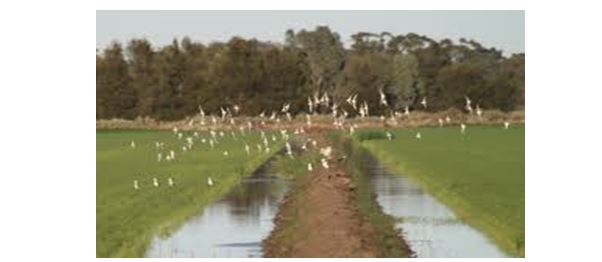Ron Pike Water on the Brain
There is a dangerous madness afoot in the Murray-Darling Basin. With the lunacy of green alarmists now firmly wed to the self-interest of a money-soaking bureaucracy, a problem that did not exist is being “remedied” with policies guaranteed to create a genuine disaster.
As the long Millennium Drought dragged on and stored water became scarce, authorities correctly rationed its use to ensure basic needs would be met, even if the drought continued. Annual-crop irrigators were getting little or, in most cases, no water at this time. But environmentalists used this naturally recurring situation to make sensational claims and blame irrigators, miners, even the building of dams, for environmental problems that did not exist. They failed to appreciate that, despite the drought being the longest in over two hundred years and our vastly increased water needs as a result of population growth, sensible water management had kept most of our rivers running and all basic water needs supplied throughout the drought. This was in stark contrast to the four droughts in the hundred years prior to 1915, when the rivers of the MDB ran bone dry.
A bone dry Murray River in 1915 and same spot at the peak of Millennium Drought.
Emotion and sophistry replaced truth and reason. Our rivers were dying as the result of extraction by irrigators, it was asserted, and lack of flow in the Murray was the cause of hyper-salinity in the Coorong. Claims of dying river red gums, drying wetlands and species loss were repeated with graphic but mostly misleading detail. It was even claimed the long drought was the new normal — the dams would never fill again, according to one of Tim Flannery best-known false prophecies – and we would all have to use less water as a result.
These claims were dubious at the time and have since been proven entirely false, with detailed and unchallenged rebuttals widely available. As you might expect, the bureaucracy created to correct these illusory problems remained unmoved. Politicians in Canberra and Sydney replaced what had been proven to work over the course of a century with a water-management policy imposing disastrous consequences on communities across the MDB, not to mention state and federal budgets. Today, the prevailing policy destroys our capacity to produce food and fibre even as it impacts the very environment its architects claim to be saving.
Political acceptance of water-availability falsehoods initially led to the wasting of billions of dollars on unneeded desalination plants, all of which are now mothballed and costing taxpayers millions of dollars every week in interest payments and maintenance expenses. These costs and overheads is what governments are trying to recoup with increasing water charges.
Committed to correcting a problem which they did not understand and which did not in fact exist, federal and state governments legislated to give bureaucracies control of stored water. They also negated the sovereign right to use the water that falls from the sky by implementing the Murray-Darling Basin Plan and, at state level, unworkable water-sharing plans.
Surely, before these actions were taken, legislators should at least have asked a few pertinent questions. Is there really a problem? What is “the environment”, where is it, and why does it suddenly need more water? Can we conserve more water in times of excess for use in dry times? What are the likely consequences of any action we may take?
These basic, vital questions were never asked by politicians and, as a result, never answered by environmentalists or bureaucrats. It was blindly accepted that “the environment” was some Garden of Eden-like place known only to greens, a paradise that could only be reclaimed by strict adherence to their dictates. The result has seen the removal of water from thousands of hectares of productive farmland that was also pristine habitat for aquatic species. Much of this habitat — like that pictured below — is in cropping fields and run-off wetlands established by farmers over several generations.
This productive water is now being flushed to the sea by bureaucracies inspired by an unneeded and misguided attempt to replicate river flows prior to the former, successful program of water conservation. The MDB Plan being implemented is doing the exact opposite of what is claimed. It is reducing the wetland footprint. It is killing river red gums. It is denying aquatic species the breeding habitat that has been both their home for decades and the reason for their increased numbers.
At the same time this plan is causing damage and hardship to Australians in regional communities across the vast Murray-Darling Basin. Using figures from the Australian Bureau of Statistics (ABS), the NSW Irrigators Council calculated that for every million megalitres of water removed from productive use, there is a $940 million loss in production at the farm gate. The most insidious result has been that water required by those who grow our food has become unavailable when required and too expensive when it is available. While the MDB Plan is destroying regional economies it is also dearly costing governments dearly, as $500 million annually is being lost in tax revenue, plus administration costs of nearly $100 million a year.
“When it comes to the MDB plan, the environment has had primacy over human, social and economic considerations,” according to farmer and Mayor of Griffith John Dal Broi. “The Plan has taken away people’s confidence and their ability to grow our town.”
Fellow Griffith Councillor and almond farmer Paul Rossetto explains the flow-on effects from reduced rice production alone, which has been felt across other industries throughout the community: “In the last two seasons in our Griffith area, rice production was down by a third. That represents a cash-flow loss of between fifty- and sixty-million dollars per year. This loss of cash flow affects everyone and is why we have seen over one hundred businesses close their doors in the Griffith district,” Mr Rossetto said.
There is more of the same from Deniliquin’s mayor, Lindsay Renwick, who has said: “From the 1950’s I have seen my town and community grow as a result of water being made available for irrigation. I am now watching my community lose business, population and hope as a result of water and forestry policy.”
Independent Senator John Madigan, who argued for the Senate inquiry into the MDB Plan, said: “When the MDB Plan was introduced to the Senate it made no sense to me, and when I asked other Senators what it was about, they had no bloody idea. Having now listened to the people affected, I have no doubt the Parliament has made a big mistake.”
The Mayor of Moree Plains Shire, Katrina Humphries said: “I have been in business in Moree for 32 years and we are all adversely affected because the rural sectors who generate our wealth are suffering. They are uncertain about their future, because the buying of water by the Commonwealth and State has seen a loss of jobs in our community.”
Third generation Griffith Businessman and Supermarket owner, Paul Snaidero said: “We survived the drought, but we cannot survive the MDB Plan. People are leaving our area and property values are plummeting; if this was occurring in Sydney, Melbourne or Canberra there would be such outcry it would likely change the government.”
Research by the Institute for Applied Ecology at the University of Canberra has shown the rice fields of the Riverina were once the biggest frog breeding grounds in Australia. Their research calculated that about five billion frogs will be bred in the rice fields every year if approximately 150,000 hectares of rice is sown. Since the plan was introduced, rice production in the Riverina has declined by a third and is continuing to fall, resulting in a declining area of aquatic habitat and frog population.
Frogs are only one part of the food chain in rice paddies and other irrigated crops. At the top are the wading birds, one of which is the endangered bBittern. Recent research has shown that it is the annual rice crop which is the species’ preferred breeding habitat. As with frogs, the bitterns’ preferred breeding ground is being reduced by this irrational Plan.
Submissions being presented to the current Senate inquiry repeatedly demonstrate that the present Plan can and should be replaced with a much better one that would permanently correct the problems of the Coorong and Lower Lakes and eradicate European carp from our rivers. Such a Plan would provide all of our water needs for the next century, including extra water for SA; while providing jobs in again prospering communities across the MDB.
If correctly managed, our nation is blessed with abundant water, meaning neither man nor beast ever need be thirsty. Across the vast, fertile plains of the MDB we have the land, the climate, the know-how and people with the expertise to grow our food and fibre. All that needs to be added to this repository of experience and common sense are water and power, both of which can be supplied in abundance by sound, fact-based policy.
It is not water that we lack. It is leadership and intelligence.
Ron Pike is a water consultant and third-generation irrigation farmer
Comments are closed.


